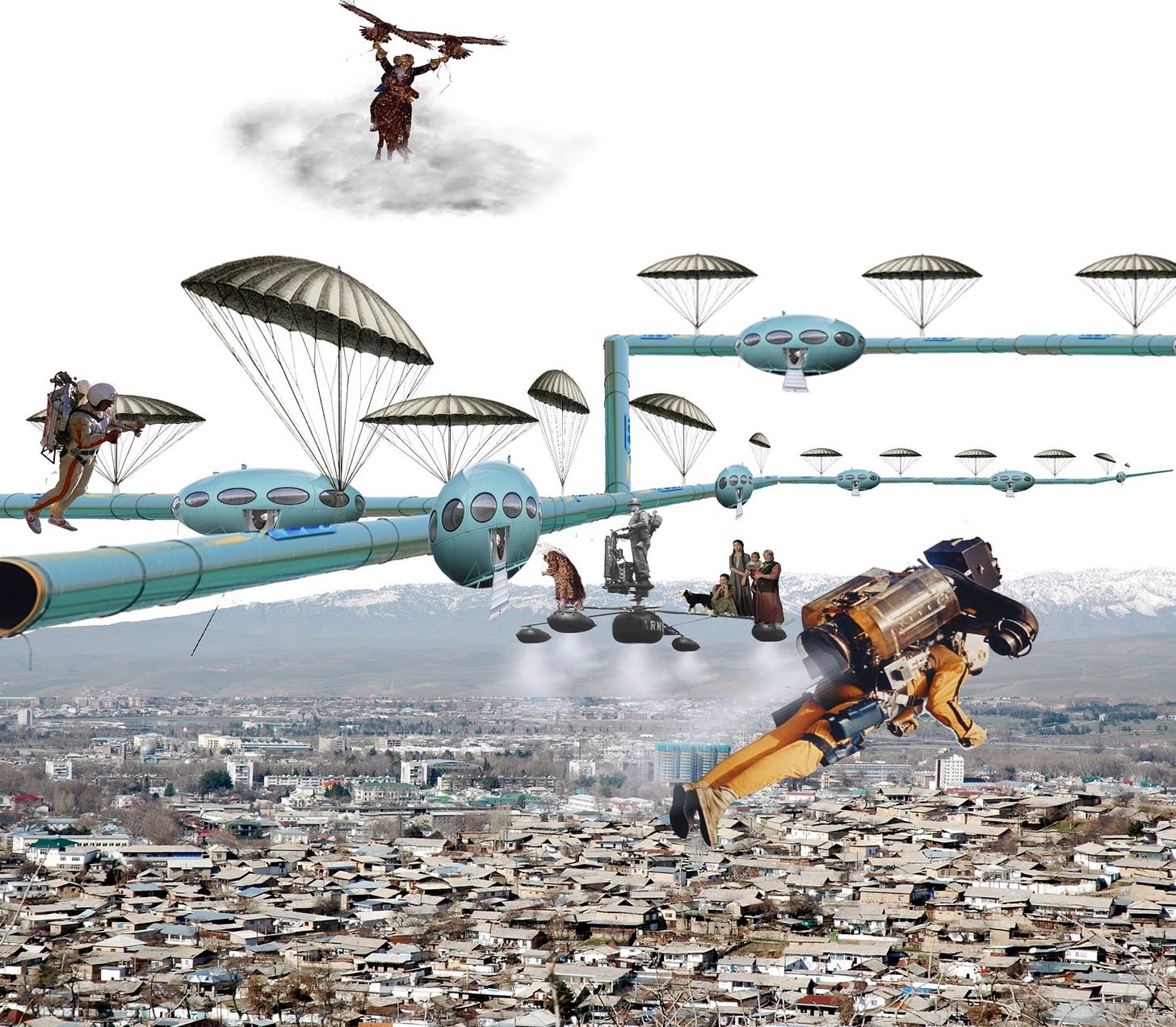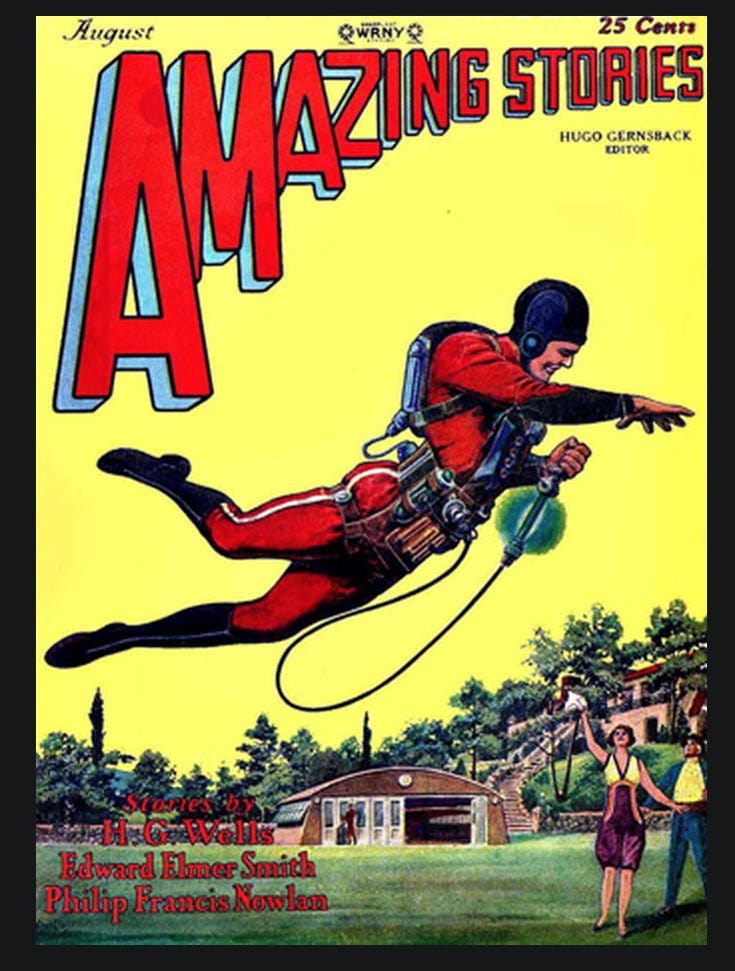Image by Summer Adlparvar
Buck Rogers[1] in the 1928 comic book, “Amazing Stories,” could be the first depiction of our imagining of the modern day jetpack.
The dream continued with imaginings in the movie, “King of the Rocketmen” in 1949 with jetpack rocketmen characters
.
“The Jetsons”, made a lasting impression on American iconography and as a conceptual model of our future.[2] Although, it ran as a television series for only one year from 1962-1963, it continues to be used when talking about the future.[3] The Jetsons are best known for their flying cars, but they did use jetpacks for recreation from time to time.
.
It is a well-known practice among engineers and scientists to read science fiction for not only entertainment but for inspiration. By 1966, Bell Aerospace had obtained the first patent on a jetpack made primarily for military use.[4]
The whole world collectively saw the use of a jetpack in a space walk in 1984, taking it out of the realm of science fiction. Yet it was still not seen as an earthly pursuit.
By 2017, jetpacks had become more affordable and cost in the range of an expensive private automobile like a Tesla. Martin Aerospace offers them for sale for around $150,000. The Emirate of Dubai has purchased a fleet of them for their firefighters and an occasional jetpack can be seen flying among the buildings like a bird through a forest.
From my view as a former U.S. Department of Transportation Chief Counsel of the Research and Innovative Technology Administration, I worked on emerging technologies like a hydrogen powered economy and how it might be regulated. I saw the emergence of the drone and even the possibility of the Segway as a new mode of transport. So it is certainly possible that the jetpack, now regulated by FAA, could be a new transportation mode that is ripe for consideration for regulation in the not-too-distant future.
The evolution of drone regulation as a case study is useful for informing an analysis of the future of jetpack regulatory substance and process. Space law with regulatory responsibility in FAA will be a foundation for the potential regulatory development of jetpacks within FAA. The Segway did not fit neatly into one category within the U.S. Department of Transportation, but was delegated to NHTSA (car safety and regulation) to consider. (The Segway did not become the next dominant mode of transport, but it is in use with various tour companies in large cities.) With these models that demonstrate rapid adoption of new transport or just failure to achieve widespread adoption, we can consider this as we think about using the unique and distinguishing features of jetpacks.
Do we regulate jetpacks?
In short, the Federal Aviation Administration regulates the category of flight equipment called “ultralights” in which jetpacks are included. But formally, the FAA has left the regulation of this entire class of equipment to the hobbyists who have an interest in safety and public confidence in the activity. This has worked well, as long as the jetpack has been a novelty for the wealthy hobbyist or one of a handful of companies seeking to build military jetpacks or the first commercial jetpack. The FAA has not updated their regulations in decades –in fact, since 1984---for ultralight vehicles (21 CFR §103) which is the current regulatory category for jetpacks. Even if FAA believes it is time to update these regulations, they probably do not have the statutory authority to do so.
Current regulations for lightweight vehicles, which include “jetpacks”, total 593 words. They do not account for any practical use of jetpacks and limit their use so narrowly that currently, it would be virtually impossible for someone to use a jetpack for any practical transportation, like going to work. For example, current regulations prohibit the use of jetpacks over populated areas. The regulations do not define what “populated” means, and anyone living in a neighborhood might easily fall under a common understanding of the term “populated” area, thus being unable to use a jetpack. Forget working late at the office or staying out after dark, because jetpacks can only be operated in daylight hours. If you have to pick up your children from daycare, that would also be a problem since only one person may be transported by a jetpack.
In summary, the Federal Aviation Administration does currently regulate jetpacks, and its enabling legislation strongly confirms that the FAA has authority to regulate air safety for anyone flying in it,[5] and emergency authority is also available for public safety purposes.[6]
At what point should jetpacks be regulated?
Currently, the limited use of jetpacks demands no public safety regulation. Jetpacks are still novelties and performers use them, like an event during Comicon in San Diego, where a performer dressed like the Avenger, flew a jetpack hovering above the street warranting special news reporting. This kind of report might have been like reports of the first gliders and airplanes in 1904 and in airshows, thereafter. At what point does a technology go from being a parlor trick to a useful technology that becomes part of the culture of a society?
Economics have to be in favor of such a transition. Horses to cars, presumptively reduced time and many believed, pollution. The fuel used in a jetpack could also open the door to faster adoption if it could use water or air as fuel. But the first practical jetpack by Martin Jetpack is powered by a gasoline engine, and can be fueled at the nations network of gas stations.
Theories of technology transitions
We can also look to theories of adoption of emerging technologies for some insight into jetpacks. The Gartner’s Hype Cycle, describes how a technology comes into widespread use:
Technologies start with a trigger, fail to rise to the peak of inflated expectations, only to plummet in the trough of disillusionment, from which it can slowly climb the slope of enlightenment to finally reach the plateau of productivity.[7]
There are plenty of disappointing examples of promising technologies which failed to be adopted or other technologies took the lead. For example, the Gartner Hype Cycle for 2012, shows autonomous vehicles climbing the curve of expectations. Ten years later in 2022, where would you place it on the curve? Has it fallen into the “trough of disillusionment.”[9] or is it climbing up the “slope of enlightment”?
Jetpacks may be at the bottom of the expectations curve in 2022; but in ten to twenty years we may see it climbing the slope of enlightment.
Gartner’s Hype Theory Graphic
Modeling previous transitions
Transitions in transportation from horses to cars can be instructive in anticipating regulatory controls that are neither too soon or too late. But recent regulatory efforts with the sudden explosion in drone technology and affordability and ubiquity drove the need for regulation.
The recent experience with the evolving licensure and regulatory promulgation by FAA for drones addressed some aspects of drone safety (part of the mission for FAA), but did not address many of the privacy concerns that were implicit in this new technology. Similarly, jetpack regulation would likely address primarily safety concerns, with FAA as the regulating authority, but privacy issues are important to consider just as drone regulation restrictions drones in what they can “see”.
Recommendation
Here are some steps that I would recommend if we want to seriously start considering jetpacks as a mode of transportation for the public, now that it has reached the beginning edge of affordability and safety:
•Begin a dialogue with manufacturers and the USUA
•Allow operation in urban areas, but follow roadways only, at a designated altitude
•Allow more than one person on the vehicle
•Allow night operation with night lighting like automobiles
•Pilot licensing with training, much like automobiles
While autonomous vehicles are projected to dominate the highways in 2050, humans may take to the skys with their own controllable jetpack to run errands and attend to their obligations. However, the rate of accidents, lack of traffic lights and air traffic controllers for jetpacks may very well have that unintended consequence of increasing traffic fatalities. Let’s hope the foresight of Congress, FAA and the informed public will consider the risks and regulate accordingly.
[1] Buck Rogers is a registered trademark, although ownership of it is in dispute.
[2] Not everyone thinks of jetpacks as a good thing. See Devon Maloney, “The Jetsons is actually a bone chilling dystopia,” The Verge (Nov. 3, 2017) at https://www.theverge.com/2017/11/3/16598440/jetsons-dystopia-dc-comics-future-apocalypse (visited Apr. 29, 2018).
[3] “The Jetsons,” Smithsonian Magazine,
[4] Bell Aerospace Patent No. 3,243,144, “Personal Propulsion Unit,” Filed July 17, 1964 (March 29, 1966).
[5] 49 U.S.C. § 1301, et. seq.(1970).
[6] 49 U.S.C. § 1485 (1970).
[7] Tilberg, quoting Fenn, 1995.
[8] Christine Zhao, “Is the iPhoneX racist? Apple refunds device that can’t tell Chinese people apart, woman claims, ” Time Magazine online, Dec 18, 2017 at http://www.newsweek.com/iphone-x-racist-apple-refunds-device-cant-tell-chinese-people-apart-woman-751263.
[9] See Gartner’s hype theory chart periods of development of an emerging technology. If you would like to see the 2022 Gartner hype chart you can find it here: https://www.gartner.com/en/articles/what-s-new-in-the-2022-gartner-hype-cycle-for-emerging-technologies .











